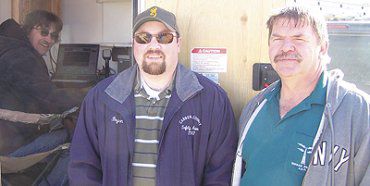Members of the Sinbad Desert Amateur Radio Club met to take the licensing test near the Wedge Overlook. This was the annual spring outing for the SDARC club that includes members from Carbon, Emery and surrounding counties. Amateur radio is often called ham radio and is both a hobby and service in which participants use various types of radio communications equipment to communicate with other radio amateurs for public service, recreation and self-training.
Friday night some of the members and their families had a large campfire. Around the fire ring they bragged about the places around the world where they had talked on their radios. The types of radios, kinds of antennas, how much gain was used and how many watts of power was necessary to make the radio contact. During Friday night radio contacts were made with ham radio operators from as far away as Europe and Asia. Two contacts in Japan were reported. Saturday radio signals from ham radio stations in Arizona and along the Southern United States and Mexico were coming in very well.
On Saturday at 10 a.m. those that thought they had studied enough to pass the test to become a ham radio operator in one of the three classifications; technician, general or the extra class were given the opportunity to try. Not all of those taking the tests passed. However six did pass the tests and will get their license or their license upgraded to a higher level. Bret Mills of Castle Dale and Bryan Anderson of Huntington were two of the instructors and volunteer examiners for the test. Ross Sacco of Price was the volunteer exam administrator with the help of two other volunteer examiners. Three examiners are required to administer a ham radio test.
To pass the ham radio test an individual has to study the 392 questions, 35 of which will be on the technician test. Learning Morse code is no longer required to be a ham operator at any level or class. The Element 3 General Class has 484 questions of which 35 multiple choice, will be on the test. A passing grade is to answer 74 percent of the questions correctly. Practice tests are available at QRZ.com.
The amateur radio tests cover such things as how to talk to fellow hams, the ionosphere, signal propagation, sun spots, radio band frequencies, electronics, FCC rules and antennas.
After the test a photo was taken of those who took the test, the instructors and those that administered the test.
At this spring outing Jim Anderson, KJ7S demonstrated the Emery County/SDARC, Emergency Communications Portable Operations Center.
This communications trailer is equipped with two high frequency radios (one of which is a flex radio attached to a computer) three dual band radios, and one public service radio. They are ready to provide emergency communications anytime, anywhere, when normal communications are unavailable.
The rest of the afternoon was taken up with riding 4- wheelers, visiting the Wedge and of course listening to ham radio signals. That evening during the steak fry George Ingram of Price gave training about the National Traffic System which is the American Relay League sponsored amateur radio message-handling network. Handling of third party traffic is one of the oldest traditions of amateur radio.
The National Traffic System nationwide has hundreds of local and section networks that meet daily to facilitate the delivery of messages. In Emery County the net usually meets at 9 p.m. using the repeater on Horn Mountain or other mountains that are linked to repeaters on mountains all over the state of Utah. These repeaters for relaying messages were put up, on the mountains, from funds donated by amateur radio clubs. The repeaters are maintained by the same radio clubs.
What do ham radio operators do besides listen for radio signals from far away places? They provide emergency communication services in times of emergencies such as the Crandall Canyon Mine Disaster, Katrina, the destruction of the World Trade Center in New York, etc. They assist in search and rescue operations. Groups floating the Green River use local ham radio operators to get help to those in need of assistance. When the World Trade Center went down, the communications towers on top of the buildings went down also. The loss of the communications towers required ham radio operators to fill in communications with their mobile and handheld radios communicating through repeaters on other buildings in the city.
Recently in California on April 9, some saboteurs opened two manholes in San Jose and two manholes in Santa Cruz, Calif. and cut the underground fiber optic cables. The cutting of those cables interrupted all of the city’s communication capabilities including telephone, 911 the Internet, and cellular phones. Ham radio operators in and around these cities were called on to provide communications for the hospitals and the police. They are the extra eyes and ears to assist in any emergencies.
Ham radio operators are a valuable asset to the local community, to the nation and to the world. An estimated 6 million people throughout the world are regularly involved with amateur radio. Ham radio began officially in the early 1900s.
Sheriff LaMar Guymon said, “The ham radio service offered by our local club is very valuable to our whole communications sytem and our ability to maintain communication should our regular avenues of communication be disrupted. Ham radio is a real asset to our county. Ham radio works when nothing else will. We always use ham radio communications for the Friendship Cruise each Memorial weekend along the Green River. It is the only communications service which works along that river corridor. We highly support our local club and the important role they play in the safety of our county.”
Ham radio always there to help out

"Jim Anderson inside the door of the communications trailer. Bryan Anderson and Bret Mills at the training and testing event at the Wedge."
